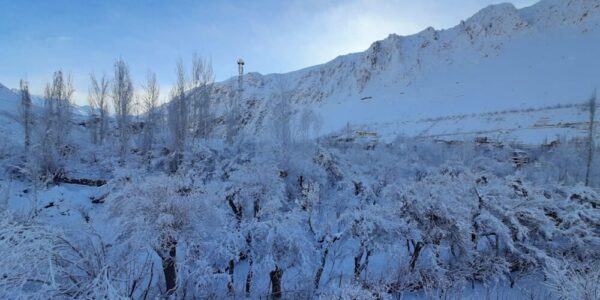Ladakh’s Snowmelt Irrigation System Faces Decline
Everyone in Ladakh was thrilled and relieved when the region finally saw its first snowfall in February after long anticipation. Ladakh is a cold desert, and its arid climate makes conditions harsh for agriculture where water scarcity poses a significant challenge to agricultural productivity, solutions are essential for sustaining food production and livelihoods. The region receives a good amount of snow during the winter months (January) creating a natural reservoir of freshwater that is crucial for sustaining agriculture during the arid summer months, unfortunately this was not the case from the last few years.
Nestled within the trans-Himalayan region, Ladakh experiences harsh and extreme climatic conditions, with a scanty annual precipitation of mere millimeters in the form of rainfall. The local communities have long relied on an ingenious source of irrigation – the abundant winter snowfall. Almost 90% of farmers in Ladakh are dependent on snowmelt water for irrigation. The gradual melting of snow, known as snowmelt, acts as a lifeline for farmers in Ladakh, enabling them to cultivate crops such as barley, wheat, and vegetables in such a challenging environment.
One of the major advantage of using snowmelt for irrigation is the sustainable and ecofriendly nature of this practice. Unlike other irrigation methods that may deplete finite groundwater resources or rely on energy-intensive pumping systems, the snowmelt-based irrigation in Ladakh is entirely dependent on the natural flow of water, making it an intrinsic part of the region’s ecological balance. Furthermore, the reliance on snowmelt for irrigation aligns with the principles of climate-resilient agriculture, as it reduces the dependency on erratic monsoon rains and minimizes the vulnerability to droughts. The slow and steady release of water from the melting snow also helps in controlling soil erosion, preventing flash floods, and maintaining the ecological balance of Ladakh’s fragile mountain ecosystems.
* Click to Follow Voice of Ladakh on WhatsApp *
The process begins as the winter snow accumulates in the mountains, gradually forming thick blankets of snow that store vast amounts of water. As the temperatures rise with the arrival of spring and summer, the snow starts to melt, releasing a steady supply of freshwater that flows downhill into the surrounding agricultural fields. This gradual release of water not only provides essential moisture for crop growth but also helps replenish groundwater reserves, ensuring the sustainability of the local ecosystem. It is connected with networks of channels and canals, being meticulously designed to direct the precious snowmelt to the fields.
However, as climate change continues to exert its influence, altering precipitation patterns and accelerating glacial melt in the Himalayan region, the sustainability of snowmelt-based irrigation faces new challenges. The need for adaptive strategies, like use of drip and sprinkler that requires less water for irrigating crops are successful in Ladakh. The best part is that government is providing subsidy on such initiatives. Mulching is one of the new approach that conserve moisture and the requirement of irrigation declines. It can be done by using crop residues, straw and black polythene which brought relief to large number of farmers in Ladakh. Ice Stupa, a piece of art and reform of glacier grafting technique that creates artificial glaciers, used for storing winter water. The water is channelized to irrigate the fields during the summer when increase in temperature melts the ice.
In conclusion, snowfall, serves as a powerful source of irrigation that sustains agriculture in Ladakh. Its role in ensuring food security, preserving ecological balance, and adapting to changing climatic realities underscores the rich potential of nature-inspired solutions in building resilient agricultural systems. As we navigate the complexities of a changing world, the timeless wisdom of snowmelt-based irrigation in Ladakh offers invaluable insights for nurturing a sustainable and harmonious relationship between humanity and the natural world.
1 Comments
Leave a Reply

Over the years the negatives boom in tourism has resulted in overdrawing of ground water which was never felt the need to harness for agriculture as snowmelt water was more than sufficient for plantation.Now this water source is finishing rapidly